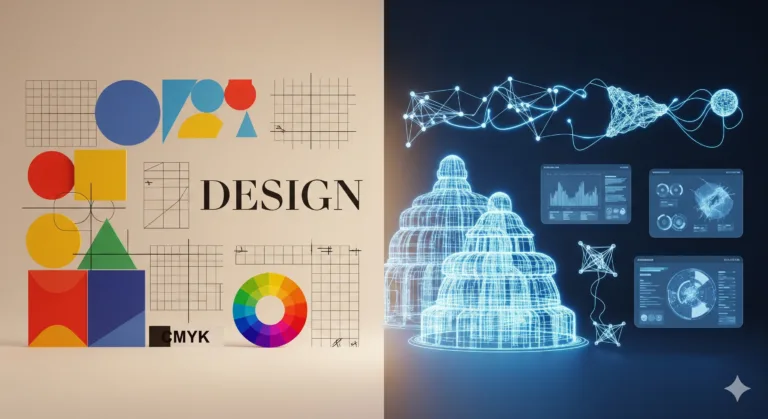Why Design Basics are Fundamental?
Are you just starting out in the exciting world of design? Maybe you feel a little lost, looking at amazing visuals and wondering how they are made. Don’t worry, everyone starts somewhere! Understanding the core building blocks is the first step to creating beautiful and effective designs yourself.
Think of design basics like learning the alphabet before writing stories, or mastering basic chords before composing music. These fundamentals give you the language and tools to express your ideas clearly and powerfully. Without them, your designs might feel random or ineffective, struggling to connect with your audience.
Learning these principles isn’t about following rigid rules; it’s about gaining control and confidence. It empowers you to make intentional choices that elevate your work from good to great. In this guide, we’ll break down the essential concepts, showing you just how simple and rewarding it is to grasp the core of great design.
By the end, you’ll have a clear picture of what makes designs work and how you can start applying these ideas to your own projects right away. Get ready to unlock your creative potential and build a strong foundation in design!
Table of Contents
What Exactly are Design Basics?
So, what do we mean by Design Basics? At its heart, it refers to the fundamental elements and principles that form the foundation of any visual creation. These are the essential concepts artists and designers have used for centuries, applied across everything from painting and sculpture to modern graphic design and web layouts.
The elements are the things you put into a design – like lines, shapes, colors, textures, and type. The principles are how you arrange those elements – concepts like contrast, balance, alignment, repetition, proximity, and hierarchy. Understanding both is key to making your work visually appealing and effective in communicating its message.
Imagine baking a cake. The elements are your ingredients – flour, sugar, eggs, butter. The principles are the recipe and techniques – how you mix, the temperature you bake at, how you layer. You need good ingredients (elements) and the right method (principles) to get a delicious result. Design works the same way!
These core ideas are universal. Whether you’re designing a logo, building a website, creating a poster, or even arranging furniture in a room, these basics are your toolkit. Mastering them allows you to create harmony, guide the viewer’s eye, and ensure your message is received loud and clear.
The Essential Pillars of Design Basics
Let’s explore some of the absolute must-know concepts that form the pillars of understanding Design Basics. These are the foundational ideas that will inform almost every design decision you make.
- Line and Shape: Think of lines as the starting point – they can be straight, curved, thick, or thin, creating outlines or textures. Shapes are formed by lines enclosing space – circles, squares, triangles, or more organic forms. They define objects and areas within your design, giving structure and form. Different shapes evoke different feelings; circles are soft and complete, squares are stable, triangles can suggest direction or energy.
- Color: Color is incredibly powerful. It sets mood, grabs attention, and creates relationships between elements. Understanding basic color theory – like warm vs. cool colors, complementary colors, and how colors affect emotion – is vital. Using a consistent and intentional color palette makes your design feel cohesive and professional.
- Typography: This is the art of arranging type. Choosing the right fonts (or typefaces) and setting them effectively is crucial for readability and conveying personality. Different fonts have distinct vibes – some are formal, others playful, some modern, some classic. How you size, space, and pair fonts drastically impacts your message.
- Space (White Space): This refers to the areas around and between elements in your design. Often called “white space” (though it doesn’t have to be white!), it’s not just empty filler. It helps separate and organize information, improves readability, and gives your design room to breathe, preventing it from looking cluttered or overwhelming. Strategic use of space creates visual hierarchy and guides the eye.
- Contrast: Contrast is about creating difference between elements. This could be light vs. dark colors, large vs. small type, smooth vs. rough textures, or busy vs. simple areas. Contrast makes elements stand out, creates visual interest, and helps establish hierarchy, drawing attention to the most important parts of your design.
- Alignment: Alignment is about arranging elements so their edges line up along imaginary vertical or horizontal lines. This creates a sense of order, cleanliness, and professionalism. Even slight misalignments can make a design look sloppy, while good alignment provides structure and makes the information easier to scan and process.
- Hierarchy: Hierarchy is the visual arrangement of elements to show their order of importance. It guides the viewer’s eye through the design, starting with the most crucial information and moving down to less important details. You create hierarchy using size, weight, color, contrast, and space to make certain elements more prominent than others.
Mastering these pillars provides a solid foundation for creating visually appealing and effective designs. Practice identifying them in designs you admire and think about how they are used.
Mistakes That Can Ruin Your Design Basics Application
As you start applying these Design Basics, you’ll inevitably make mistakes. That’s perfectly normal! Learning to recognize common pitfalls is just as important as learning the principles themselves. Avoiding these issues will significantly improve the quality and effectiveness of your work.
- Over-cluttering the Layout
Problem description:
Beginners often try to fit too much information or too many visual elements into a small space. This results in a busy, overwhelming design where nothing stands out, and the message gets lost.
Solution: Embrace white space! Be ruthless in deciding what’s truly necessary. Give elements room to breathe. Prioritize information and remove anything that doesn’t serve the main goal. - Poor Color Combinations
Problem description:
Using colors that clash, are difficult to read against each other, or don’t match the intended mood can make a design look amateurish and even hard to look at. Ignoring color contrast, especially for text, is a common accessibility issue.
Solution: Learn basic color theory (like the color wheel). Use online color palette generators to find harmonious combinations. Always check color contrast, especially for text, to ensure readability for everyone. - Inconsistent or Too Many Fonts
Problem description:
Using too many different fonts (typefaces) in a single design creates a chaotic and unprofessional look. Inconsistent sizing, spacing (leading and kerning), or styling also undermines visual harmony.
Solution: Stick to a maximum of 1-3 font families per design. Choose fonts that pair well. Be consistent with your typography styles (e.g., always use the same size for body text, same style for headings). Learn basic type pairing rules. - Ignoring Alignment
Problem description:
Elements are placed seemingly randomly on the page without lining up with anything else. This makes the design feel messy, unorganized, and difficult for the eye to follow.
Solution: Use grids or guides in your design software. Choose an edge (left, right, center) or a baseline to align your text and objects. Consistent alignment instantly makes a design look more polished and structured. - Lack of Visual Hierarchy
Problem description:
Everything on the page looks equally important (or equally unimportant). There’s no clear starting point, and the viewer doesn’t know where to look first or what the main message is.
Solution: Use contrast (size, color, weight) to make the most important elements stand out. Guide the viewer’s eye through the information in a logical order. Make headlines larger and bolder than body text, use color to highlight calls to action.
Recognizing these mistakes in your own work and others’ designs is a huge step forward. Don’t be afraid to iterate and refine!
Step by Step: Applying Design Basics to Your Projects
Ready to put these Design Fundamentals into practice? Here’s a simple step-by-step approach you can use for your next project, whether it’s a social media graphic, a simple flyer, or a blog post layout.
- Step 1 – Understand the Goal: Before you even open design software, ask yourself: What is the purpose of this design? Who is the audience? What is the main message I need to convey? Knowing the goal helps you make intentional choices about elements and principles.
- Step 2 – Sketch Your Ideas: Grab a pen and paper (or a digital equivalent). Don’t worry about perfection. Quickly sketch different layout ideas. Where will the headline go? The image? The main text? This helps you think about space and alignment before getting bogged down in details.
- Step 3 – Choose Your Core Elements: Based on your goal and sketches, select your key ingredients. Pick a color palette that fits the mood and audience. Choose 1-3 fonts that work well together and are readable. Decide on any main shapes or graphical elements you might use.
- Step 4 – Build with Structure: Start placing your elements in your design software. Focus on alignment. Use guides or grids to line things up neatly. Think about proximity – group related items together using space. This brings order to your layout.
- Step 5 – Refine and Enhance: Now, apply principles like contrast and hierarchy. Make the most important text larger or a different color. Ensure there’s enough contrast between text and background. Use space to separate sections and guide the eye through the information logically.
- Step 6 – Get Feedback: Share your design with someone else. Ask them if the message is clear, what they notice first, and if anything seems confusing or messy. Fresh eyes can spot issues you missed. Be open to constructive criticism and use it to improve your design.
This process isn’t rigid; you’ll often jump back and forth between steps. The key is to approach your project with intention, consciously applying the basics you’ve learned.
Frequently Asked Questions about Design Basics
Here are some common questions beginners often ask when learning about Design Basics:
Q: How many fonts should I use in one design?
A: Generally, it’s best to stick to 1 to 3 different font families to maintain a clean and consistent look.
Q: How do I choose colors that work well together?
A: Start with one main color and use a color wheel or online palette tools to find complementary, analogous, or monochromatic colors that create harmony.
Q: Is “white space” really important if I have a lot of information?
A: Absolutely! White space (or negative space) is crucial for readability and prevents your design from looking cluttered, even with lots of content.
Q: Do I need expensive software to apply design basics?
A: No, you can start with free tools! The principles matter more than the software. Many free online design tools can help you practice.
Q: How long does it take to master these basics?
A: It’s a continuous journey! Consistent practice and learning are key. You’ll get better with every project you work on.
Conclusion: Design Basics in Practice
You’ve taken the first exciting step on your design journey by exploring the fundamental Design Basics. We’ve covered the essential elements like line, shape, color, type, and space, and key principles such as contrast, alignment, and hierarchy.
Remember, these aren’t just abstract concepts; they are practical tools that empower you to create visually appealing and effective designs. By understanding and applying these fundamentals, you can transform your ideas into clear, compelling visuals that communicate your message successfully.
Don’t feel pressured to master everything at once. Start by focusing on one or two principles in your next project. Practice, experiment, and learn from both your successes and your mistakes. Every design you create is an opportunity to refine your understanding and skills.
The world of design is vast and exciting, and a strong grasp of the basics is your passport to exploring it. Keep learning, keep creating, and watch your skills grow!
Deepen your knowledge by reading our article about Principles of Design!



